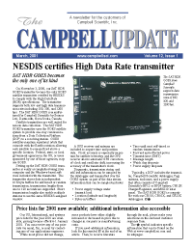Customer suggestions lead to overall improved products
Originally planned as temporary software for the "soon-to-be-released" CR9000 Measurement and Control System, our PC9000 Software has evolved over the past seven years. In its infancy, it could transfer a program to the CR9000, set the CR9000 clock, display real-time data, and collect data files. The initial program generator was soon developed; it could create programs to make fundamental measurements and support various data storage rates.
Today, all PC9000 features are captive within a Multi-Document Interface (MDI). This technology makes it easier to have several windows, of the same or different type, open at the same time. The windows can be tiled or cascaded as desired.
Requests for additions and changes to PC9000 started with our first CR9000 customers. Consequently, the Program Generator now includes Battery Saver, Status Monitor, Conditional Power Off based on time and/or measurements, Triggered Burst, Rain Flow Histogram, Level Crossing Histogram, Triggered Event Tables, Write If..., Table Times calculator and Calculated Fields. Calculators for y=mx b, RPM, Speed, Liquid Flow, mV per Volt sensors, and Potentiometers and Resistance were also added. Support for new hardware includes Conditional setups to read and write to ports, the ability to set flags and Continuous Analog Outputs, and an interface to the CR9052DC Filter Module and SDM-CAN module.
A new Alarms List real-time window allows the user to set two alarm levels for each of several different measurements. All alarm condition measurements, or combinations of measurements, are viewable in the window. Alarm conditions are also logged to a file to show the time the alarm started and ended for each alarm level.
A new DDE Linker real-time window can simultaneously display 50 channels of data. Since 10 of these windows can be open at once, up to 500 channels can be available for DDE linking. A PC running PC9000 while connected to a CR9000 can provide the logger’s data to everyone on a network. In fact, if more than one PC9000/CR9000 system is running with DDE Linkers open, then anyone on the network can access data from all loggers at the same time. The easiest way to access the data is to set up an Excel or similar spreadsheet for DDE, then select the logger and data points desired. This works well for graphically viewing data in pseudo real-time. One copy of Excel can display several graphs from the same or different loggers. Our tests have shown that it is possible to transfer up to 200 data points per second using this method. This method is not recommended to remotely collect data from a CR9000 because the DDE transfer of data may not keep up with the logger.
With the release of the CR5000, changes were made to PC9000. A new Program Generator, PC5GEN, was released that adds support for our AM25T multiplexers. PC5GEN is not an integral part of the PC9000 MDI, but is a stand-alone program that works seamlessly with PC9000.
A new editor has several features that make it easier to program the CR5000 or CR9000 beyond the capabilities of the Program Generator. This editor, also a stand-alone program, is called CSIEdit.
PC9000 help files have evolved to make it easy to obtain information during any stage of the data acquisition process, from program generation to data collection and processing.
Our forthcoming PC9000 release, a 32- bit version, required development of a new 32-bit dynamic link library (DLL). Early tests show promise for faster data collection, slightly faster real-time windows, and increased compatibility with other 32-bit software packages.
In summary, PC9000 has evolved because of suggestions made by people who use the product. All of your suggestions were welcomed and evaluated; if a suggested feature added value to PC9000, it was usually implemented.

